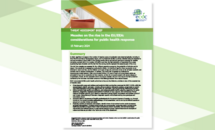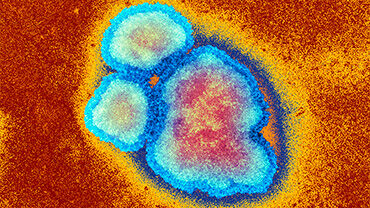Threat assessment brief: Measles on the rise in the EU/EEA - Considerations for public health response
In 2023, significant increases in the number of measles cases and outbreaks were observed globally, including in 40 of the 53 countries of the European region, and in at least ten EU/EEA countries. Measles cases are expected to continue increasing in the EU/EEA in the coming months due to sub-optimal vaccination coverage for measles containing vaccines (MCV) in a number of EU/EEA countries, the high probability of importation from areas experiencing high circulation and the fact that the coming months represent the seasonal peak of the virus.
Executive Summary
The risk from measles was assessed for four different population groups by the probability of infection and its impact. The overall risk is assessed as moderate for infants <12 months of age for whom vaccination is not indicated in most countries, and for children ≥1-5 years of age who are known to be at risk of higher morbidity and mortality due to measles complications. In addition, the overall risk is assessed as moderate for immunocompromised persons. Older unvaccinated children (>5 years of age) and unvaccinated adults are estimated to have low to moderate risk from measles, as they do not usually present with severe disease or complications. Finally, for the population that is immune to measles, the risk is low due to the high protection conferred by the two-dose vaccination scheme or the lifelong protection from natural disease. ECDC encourages EU/EEA public health authorities to focus on the following activities in view of the expected rise of measles cases:
- Close immunity gaps and achieve and maintain high vaccination coverage for MCV (>95% with the second dose). Identify and reach, including with immunisation information systems, unvaccinated or partially vaccinated populations and provide opportunities for vaccination, including during key healthcare encounters.
- Strive towards high quality surveillance, and adequate public health capacity, especially for early detection, diagnosis, response and control of outbreaks at local, regional, and national level. Prompt diagnosis facilitates reporting. Early detection mechanisms prevent further transmission and facilitate control of new clusters. Strengthening of laboratory diagnostic capacity will facilitate tracking virus genotypes and transmission chains.
- Increase clinical awareness of health professionals for the prompt diagnosis of measles, e.g. through training on the current measles epidemiology, clinical presentation, and on non-typical affected population groups such as older children and adults.
- Promote vaccine acceptance and uptake. Identify drivers of sub-optimal vaccine uptake to ensure tailored interventions. Initiatives should include risk communication, awareness raising and training for healthcare providers to support them in their conversations around vaccination, and community-based interventions that address barriers in under-served population groups. Several resources and examples of national activities are provided in the Technical Annex of this assessment.
Download








